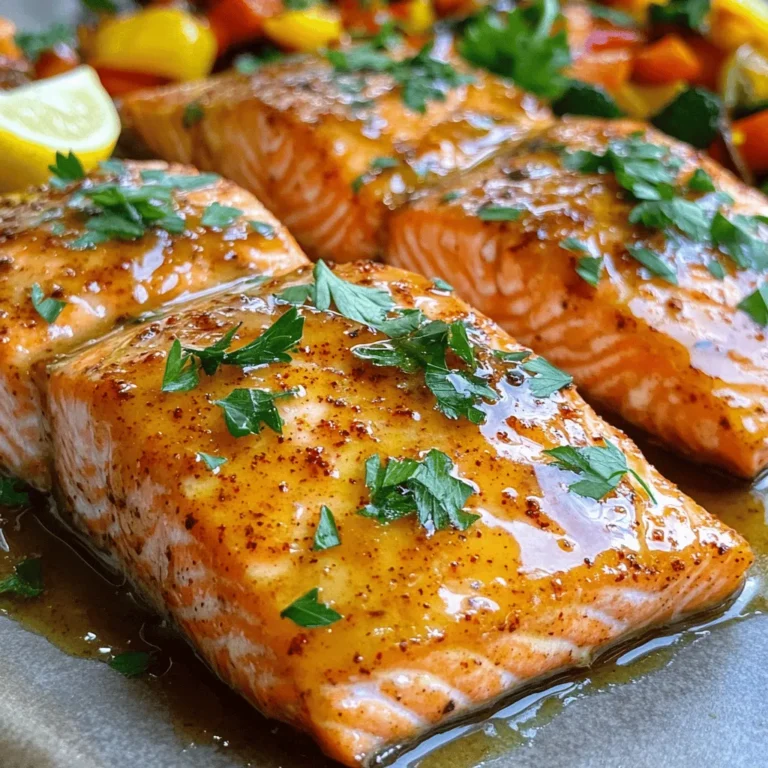Korean Beef Bowls Tasty and Satisfying Meal
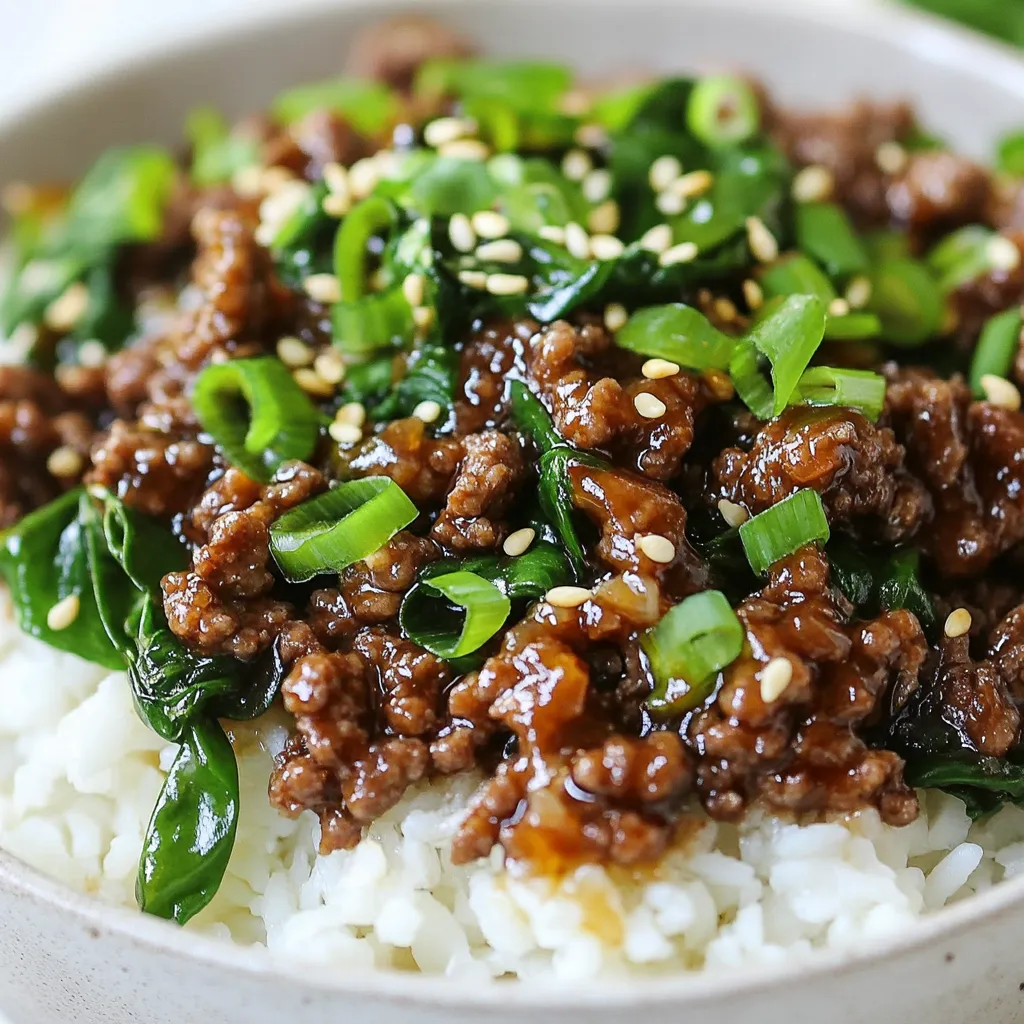
Craving a quick and tasty dinner? Look no further than Korean Beef Bowls! This dish is packed with flavor and takes only a few simple steps to prepare. With ground beef, fresh veggies, and a sweet yet spicy sauce, you’ll satisfy your hunger in no time. Let’s dive into the recipe and see how you can whip up this satisfying meal for yourself and your loved ones!
Why I Love This Recipe
- Quick and Easy: This recipe comes together in just 25 minutes, making it perfect for busy weeknights.
- Flavor Explosion: The combination of soy sauce, sesame oil, and gochujang creates a rich and savory sauce that elevates the ground beef.
- Customizable: You can easily swap ingredients like rice for cauliflower rice or spinach for bok choy to suit your preferences.
- Healthy and Satisfying: This dish is packed with protein and can be made lighter without sacrificing flavor.
Ingredients
List of Ingredients
– 1 lb ground beef or lean ground sirloin
– 3 tablespoons soy sauce
– 1 tablespoon sesame oil
– 2 tablespoons brown sugar
– 1 tablespoon gochujang
– 2 cloves garlic, minced
– 1-inch piece of fresh ginger, grated
– 2 green onions, finely chopped (reserve some for garnish)
– 1 cup jasmine rice or cauliflower rice
– 1 cup fresh spinach or bok choy
– 2 teaspoons sesame seeds
– Salt and pepper
When I create Korean beef bowls, I focus on fresh ingredients. They make a big difference in flavor. The base starts with ground beef, or you can use lean ground sirloin for a healthier choice. Each bite needs the right balance of savory and sweet. The soy sauce, sesame oil, and brown sugar combine to make a delicious sauce.
Gochujang adds a spicy kick that really brings the dish to life. Minced garlic and grated ginger round out the taste. I love using fresh green onions to add a nice crunch.
For the rice, I often pick jasmine rice, but cauliflower rice works well for a low-carb option. Spinach or bok choy adds a great color and nutrients. Don’t forget the sesame seeds! They add a lovely crunch and look great on top.
Finally, season with salt and pepper to your taste. These ingredients come together to make a tasty and satisfying meal.
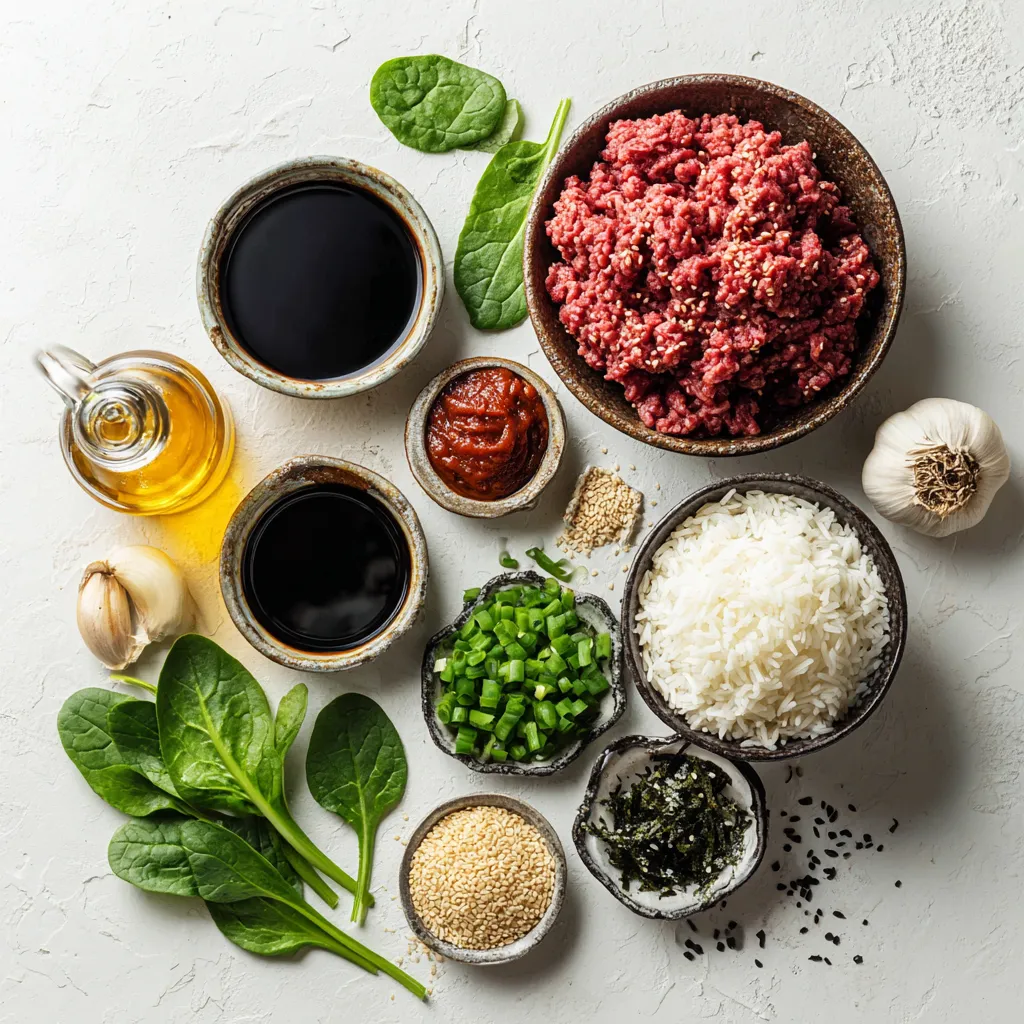
Step-by-Step Instructions
Cooking the Ground Beef
– Heat a large skillet on medium heat.
– Add 1 pound of ground beef to the skillet. Cook for 5-7 minutes.
– Stir frequently, breaking apart clumps with a spatula. Brown the beef well.
– If there is excess fat, carefully drain it out.
Preparing the Sauce
– In a small bowl, mix 3 tablespoons soy sauce, 1 tablespoon sesame oil, 2 tablespoons brown sugar, and 1 tablespoon gochujang.
– Add 2 cloves minced garlic and 1 inch grated ginger to the bowl.
– Whisk all the ingredients until they blend well.
– Pour this tasty sauce over the browned beef in the skillet. Stir to coat the beef evenly.
Combining Ingredients
– Add 2 finely chopped green onions to the skillet.
– Season with salt and pepper to taste. Mix well.
– To prepare the greens, steam 1 cup of spinach for 2 minutes until just wilted.
Assembling the Bowls
– Choose a bowl and scoop in 1 cup of jasmine rice or cauliflower rice as the base.
– Top the rice with the savory beef mixture and the spinach.
– Garnish your dish with a sprinkle of sesame seeds and some extra chopped green onions.
Tips & Tricks
Achieving the Best Flavor
For the best taste, adjust the sauce to fit your liking. You can add more gochujang if you want extra heat. Using fresh ingredients boosts flavor. Fresh green onions and ginger make a big difference. Don’t skip on these elements. They enhance the dish.
Cooking Techniques
To cook spinach, steaming works well. Steam it for just 2 minutes until it’s wilted. If you prefer sautéing, a quick stir in oil works too. Keep an eye on the beef. Overcooking can make it tough. Cook until it’s browned, about 5-7 minutes.
Presentation Suggestions
Garnishing adds fun to your meal. Sprinkle sesame seeds and extra green onions on top. Use a deep bowl to hold all the layers. A wide bowl lets you see the colorful layers. This makes your Korean beef bowl inviting and tasty.
Pro Tips
- Choose the Right Beef: For a leaner option, opt for ground sirloin instead of regular ground beef. It will reduce the fat content while still delivering great flavor.
- Balance the Heat: Adjust the amount of gochujang based on your spice preference. Start with less and add more if you prefer a spicier dish.
- Quick Cooking Greens: For the freshest taste, steam the spinach just until wilted. Overcooking can lead to a loss of nutrients and flavor.
- Perfect Rice Texture: Rinse jasmine rice before cooking to remove excess starch. This will help achieve a fluffier and less sticky texture.
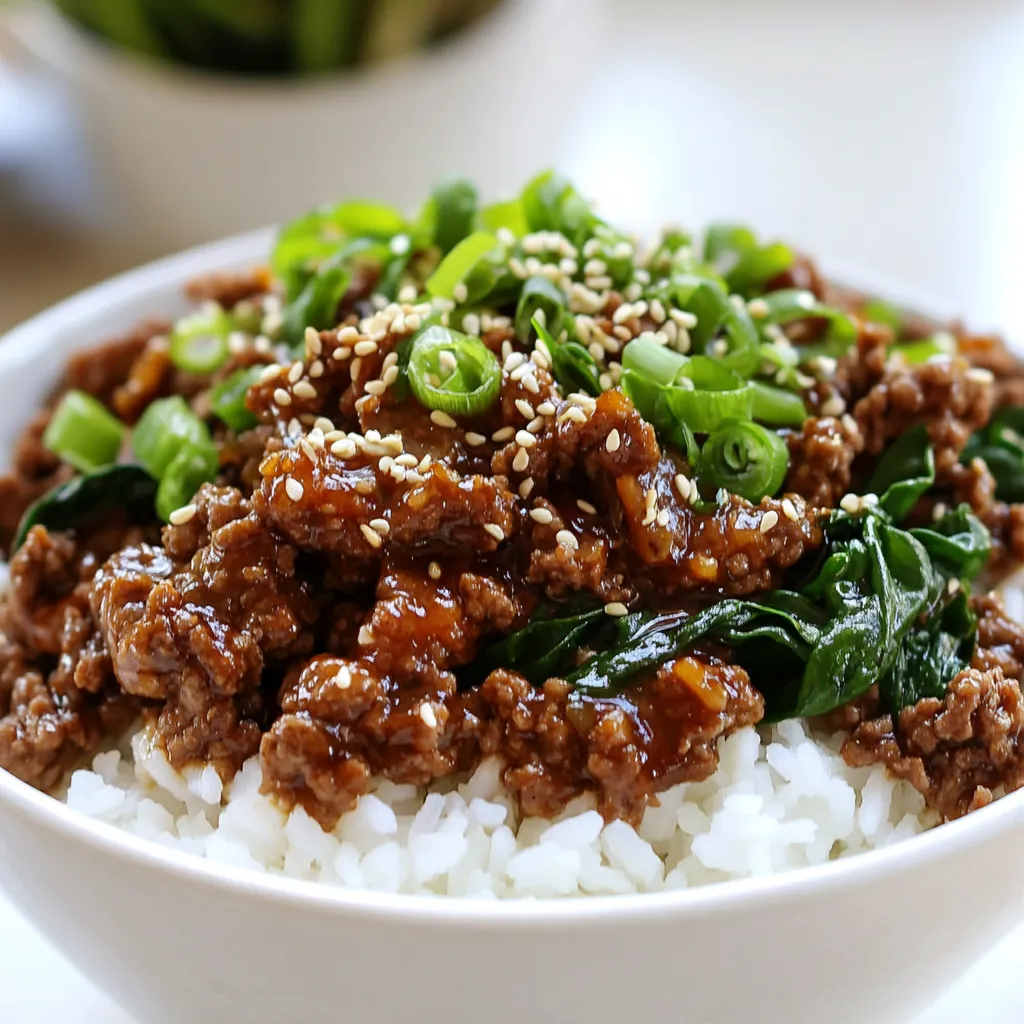
Variations
Vegetarian or Vegan Options
You can easily make Korean beef bowls vegetarian or vegan. Try substituting ground beef with plant-based alternatives like lentils or veggie crumbles. These options keep the flavor but add more nutrients. Tofu is another great choice. You can cube firm tofu and sauté it until golden. Mushrooms work well too. They add a nice umami taste and texture.
Low-Carb Alternatives
For a low-carb meal, swap out rice for cauliflower rice. You can pulse cauliflower florets in a food processor until they resemble rice. Sauté it with a bit of oil for flavor. Another option is to use greens instead of rice. Spinach or bok choy adds freshness without the carbs.
Flavor Variations
Feel free to add other vegetables to your beef bowls. Bell peppers, carrots, or snap peas add color and crunch. Adjust the spice levels to your liking. If you want more heat, add extra gochujang or sliced chilies. You can also add a splash of lime juice for brightness.
Storage Info
Storing Leftovers
To keep your Korean beef bowls fresh, store leftovers in the fridge. Place them in an airtight container. Make sure to let the dish cool down before sealing it. This helps prevent moisture buildup. You can store the bowls for up to three days.
Reheating Suggestions
When you want to enjoy your leftovers, the best way is to use the microwave. Place the food in a microwave-safe dish and cover it loosely. Heat it for one to two minutes, stirring halfway. This helps heat evenly. If you want to keep the beef juicy, try reheating on the stove. Heat it gently over low heat, stirring often. This keeps the texture nice.
Freezing the Dish
If you want to save Korean beef bowls for later, freezing is a good option. Pack the beef and rice in separate freezer-safe containers. This helps keep the rice from getting mushy. Make sure to label the containers with the date. You can freeze them for up to three months.
When you’re ready to eat, take the bowl out of the freezer. Place it in the fridge overnight to thaw. For a quicker method, use the microwave on the defrost setting. Once thawed, reheat as mentioned earlier. Enjoy your meal anytime!
FAQs
What can I substitute for gochujang?
If you can’t find gochujang, don’t worry! You can use sriracha or red chili paste. Mix these with a bit of sugar to get a similar taste. Another option is to blend miso paste with chili powder. This can give you that nice umami flavor. Each substitute will change the taste a bit, but they can still make your dish tasty.
Can I make Korean beef bowls in advance?
Yes, you can prep these bowls ahead of time! Cook the beef and sauce, then store them in a sealed container. Keep the rice and greens separate to avoid sogginess. When ready to eat, just heat everything up and assemble. This way, you save time and enjoy a warm meal fast.
How do I make the dish spicier?
To add heat, use more gochujang in your sauce. You can also add sliced fresh chili peppers or red pepper flakes. If you want a smoky flavor, try adding chipotle powder. Adjust this to your taste, and remember to start small. You can always add more spice later.
This blog post covered the key ingredients and steps to make delicious Korean beef bowls. You learned how to cook the beef, prepare the sauce, and combine all the flavors. I shared tips for the best taste and fun variations to suit your diet. Remember, fresh ingredients make a big difference. Whether you want a quick meal or a tasty change, this dish fits the bill. Try it out and enjoy your delicious creatio
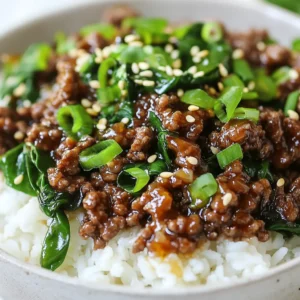
Savory Korean Beef Bowls
Ingredients
- 1 lb ground beef
- 3 tablespoons soy sauce
- 1 tablespoon sesame oil
- 2 tablespoons brown sugar
- 1 tablespoon gochujang
- 2 cloves garlic, minced
- 1 inch fresh ginger, grated
- 2 pieces green onions, finely chopped
- 1 cup freshly cooked jasmine rice
- 1 cup fresh spinach
- 2 teaspoons sesame seeds
- to taste salt and pepper
Instructions
- Heat a large skillet over medium heat and add the ground beef. Cook for about 5-7 minutes, stirring occasionally and breaking apart any clumps with a spatula, until the beef is nicely browned. If there’s excess fat, carefully drain it off.
- In a separate small mixing bowl, combine the soy sauce, sesame oil, brown sugar, gochujang, minced garlic, and grated ginger. Whisk the ingredients together until fully blended. Pour this flavorful sauce over the browned beef in the skillet, mixing well to ensure the beef is evenly coated. Allow it to simmer for an additional 2-3 minutes so that the flavors can meld beautifully.
- Add the finely chopped green onions to the skillet, and season with salt and pepper according to your preference. Stir well to combine all the ingredients.
- To prepare the greens, either steam the spinach in a pot or food steamer for about 2 minutes until it's just wilted, or sauté it briefly in a splash of oil over medium heat if you prefer a different texture.
- For assembly, take a bowl and place a generous scoop of the cooked jasmine or cauliflower rice at the bottom. Top it with the savory beef mixture and a handful of the sautéed or steamed spinach.
- Add the finishing touch by garnishing the bowl with a sprinkle of sesame seeds and extra chopped green onions to enhance both flavor and visual appeal.

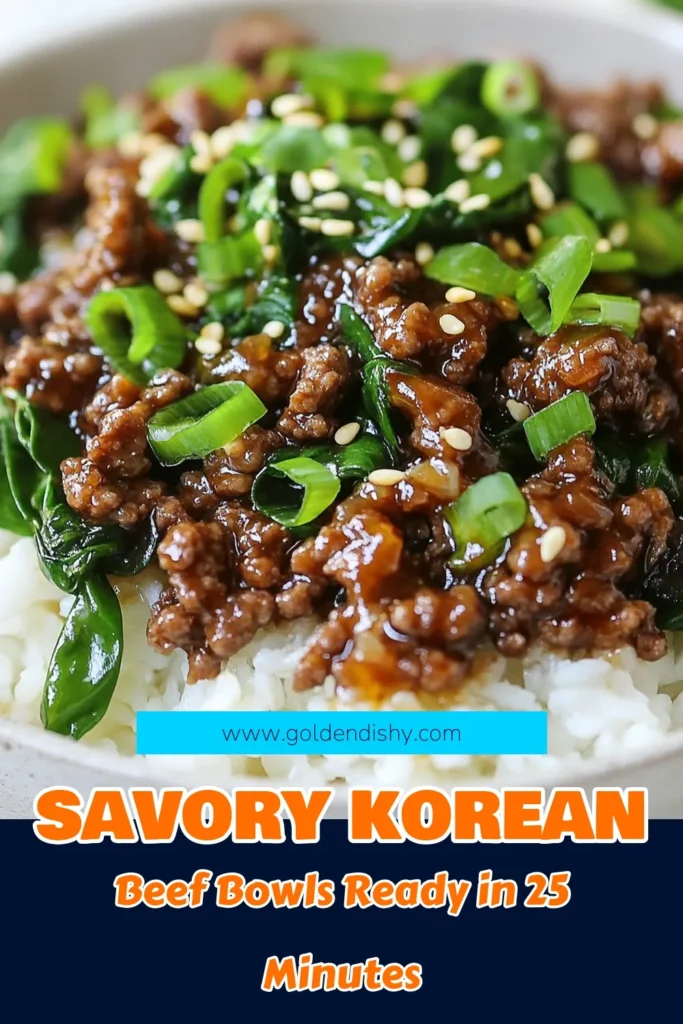
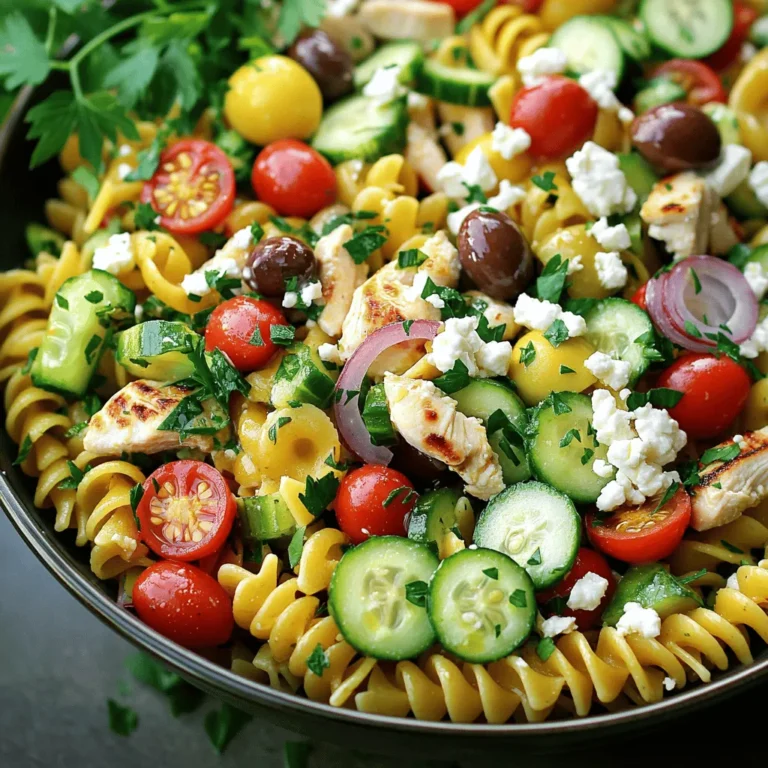
. This recipe includes all the details you need for perfecting this rich side dish. Enjoy making it! We covered the key steps to make creamy garlic mashed potatoes. First, we explored essential ingredients and shared brands to try. Next, I laid out easy prep instructions and tips for texture and flavor. Then, we looked at tasty variations, like vegan options. Finally, I highlighted how to store and reheat your potatoes. These mashed potatoes will elevate your meals. Try new variations to keep things exciting. Enjoy crafting this dish that your family will love!](https://goldendishy.com/wp-content/uploads/2025/06/88d864b9-3d37-4779-9fe5-8809feb11d6c-768x768.webp)
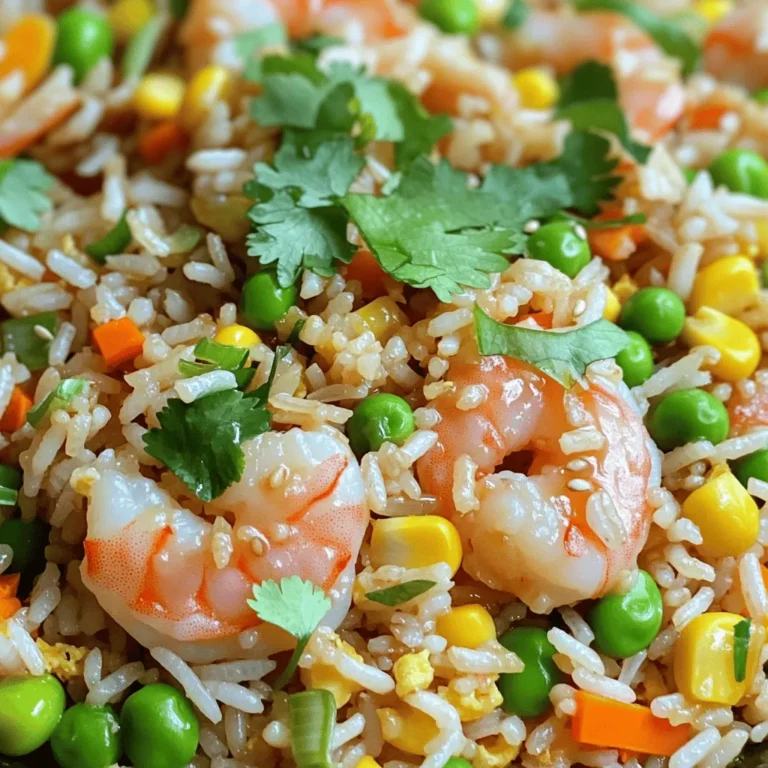
![- Bell peppers and their colors: You can use four large bell peppers. Choose any color you like: red, yellow, green, or orange. Each adds its own taste and look to the dish. - Protein options: For the filling, you can select either ground turkey or beef. Both options will give you a hearty and satisfying meal. - Base ingredients: You will need one cup of cooked rice. You can use either white or brown rice. Additionally, add one cup of black beans, rinsed and drained, and one cup of corn. You can choose fresh, frozen, or canned corn. - Flavor enhancers: To boost the flavor, use one cup of salsa. You can pick your favorite brand or make it homemade. Also, add one tablespoon of taco seasoning. You can use store-bought or make your own. - Toppings: For the top of the peppers, use one cup of shredded cheddar cheese. This cheese gives a nice gooey texture. You can add extra cheese for a more decadent touch. Fresh cilantro is a great garnish, adding color and a bit of fresh flavor. You can find the full recipe in the earlier sections of this article. Happy cooking! Preheat the oven to 375°F (190°C). This helps cook the peppers evenly. While it heats, grab a baking dish. Set it aside for the stuffed peppers. Prepare the bell peppers by slicing the tops off. Remove the seeds and membranes, which can taste bitter. Brush each pepper with olive oil. This adds flavor and helps them roast nicely. Place the peppers upright in the baking dish. Cook the meat in a large skillet over medium heat. Add 1 pound of ground turkey or beef. Break it apart with a spatula as it cooks. Make sure it browns well. Once cooked, drain any excess fat. This keeps the filling lean and tasty. Next, add rice, black beans, corn, salsa, and seasoning to the skillet. Use 1 cup of cooked rice, 1 cup of rinsed black beans, and 1 cup of corn. Pour in 1 cup of salsa and 1 tablespoon of taco seasoning. Sprinkle some salt and pepper too. Mix everything well. Simmer the mixture for about 5 minutes. This lets the flavors meld together, making the filling more delicious. Stir it occasionally to avoid sticking. Now, mix in half of the shredded cheddar cheese. This makes the filling creamy and rich. Remove the skillet from heat. Stuff the peppers by spooning the mixture into each one. Press down gently to pack it in well. This ensures every bite is full of flavor. Top with more cheese by sprinkling the remaining cheddar over each filled pepper. It will melt and brown nicely while baking. Bake the peppers by covering the baking dish with aluminum foil. Place it in the oven for 25-30 minutes. In the last 10 minutes, remove the foil. This helps the cheese bubble and turn golden. Once done, cool the peppers for a few minutes before serving. The filling will be very hot. If you like, garnish with fresh cilantro for extra flavor. Enjoy your taco stuffed bell peppers! Remember, you can find the full recipe above for all the details. How to choose fresh bell peppers: Pick bell peppers that are firm and shiny. Look for smooth skin with no blemishes. A good pepper feels heavy for its size. Colors like red, yellow, and orange are sweeter. Green peppers are a bit more bitter. All colors work well in this dish. Ensuring optimal cooking temperature and timing: Set your oven to 375°F (190°C) before you start cooking. This temperature helps the peppers cook evenly. Bake them for 25-30 minutes. In the last 10 minutes, uncover the dish to let the cheese brown. Suggestions for additional spices or ingredients: Add cumin or chili powder for an extra kick. You can also mix in diced tomatoes or jalapeños for more flavor. If you love heat, try adding some hot sauce to the filling. Offering a vegetarian option: For a vegetarian version, swap the meat for lentils or extra beans. You can use quinoa instead of rice for a healthy twist. This way, everyone can enjoy taco stuffed bell peppers! Plating ideas for presentation: Serve the peppers on a colorful platter. You can place them upright for a fun look. Add a dollop of sour cream on the side. Fresh cilantro on top adds a pop of green. Recommended side dishes for a complete meal: Pair your stuffed peppers with a fresh salad or tortilla chips. A side of guacamole or salsa also works great. These sides make the meal more fun and filling. For the full details, check out the Full Recipe! {{image_4}} You can mix up the protein in taco stuffed bell peppers. If you want a meatless option, try using black beans or lentils. They add great flavor and protein. For a twist, you can also use ground chicken or pork. When it comes to cheese, feel free to get creative. While cheddar is classic, you might try Monterey Jack or pepper jack for extra spice. You can also use cream cheese for a creamier filling. For salsa, any kind works! Chunky salsa adds texture, while smooth salsa blends in. You can even make your own with fresh tomatoes, onions, and peppers. Grilling adds a smoky flavor. Wrap the stuffed peppers in foil and place them on the grill. Cook for about 15 to 20 minutes until tender. You can also use a slow cooker. Place the stuffed peppers in the slow cooker with a bit of sauce. Cook on low for 4 to 6 hours for a hands-off approach. If you need a quick meal, the microwave is your friend. Just place the stuffed peppers in a microwave-safe dish. Cover with a lid or plastic wrap. Heat for about 5 to 7 minutes, checking for doneness. Using seasonal veggies makes your dish brighter. In summer, add fresh zucchini or corn. In fall, consider adding diced sweet potatoes or pumpkin. These add flavor and nutrition. For holidays, you can theme your peppers. For Halloween, use orange peppers and stuff them with spicy fillings. For Christmas, use red and green peppers and add festive spices. It’s a fun way to celebrate! For the full recipe, check out [Full Recipe]. To store leftovers, place the stuffed peppers in an airtight container. This keeps them fresh and tasty. You can keep them in the fridge for up to three days. Make sure they cool down first to avoid steam build-up. If you want to save some for later, freezing is a great option. Wrap each stuffed pepper tightly in plastic wrap. Then, place them in a freezer-safe bag. They can last for up to three months in the freezer. When you’re ready to eat, thaw them overnight in the fridge. To reheat, bake at 350°F (175°C) for about 25 minutes, or until heated through. For easy meal prep, you can cook a big batch in advance. Make the filling and stuff the peppers ahead of time. Store them in the fridge for two days before baking. This way, you can have a quick meal ready on busy nights. You can also use different colors of bell peppers for fun and variety. What can I substitute for rice in the recipe? You can use quinoa or cauliflower rice instead of regular rice. Quinoa adds protein and fiber. Cauliflower rice keeps it low-carb. Both options work well and keep the dish tasty. How do I know when the peppers are fully cooked? The peppers should be tender but not mushy. You can poke them with a fork. If they give easily but hold their shape, they are ready. The cheese should be melted and bubbly on top too! Caloric content and portion sizes Each stuffed pepper is about 300 calories. This includes the filling and toppings. If you use ground turkey, it may be lower in calories. Adjust the portion size based on your hunger. Health benefits of ingredients used Bell peppers are rich in vitamins A and C. They help boost your immune system. Black beans provide protein and fiber, promoting good digestion. Corn adds vitamins and a sweet crunch. What drinks pair well with taco stuffed bell peppers? A refreshing drink like lemonade or iced tea works great. For adults, a light beer or margarita adds fun. Choose drinks that balance the spice of the peppers. Can taco stuffed bell peppers be made in advance for gatherings? Yes! You can prepare the stuffed peppers ahead of time. Just store them in the fridge. Bake them when your guests arrive. They will taste fresh and hot from the oven! For the full recipe, check the earlier section. Taco stuffed bell peppers are fun and easy to make. We covered the key ingredients, steps, and helpful tips for a great dish. You learned how to mix flavors and pack ingredients for maximum yum. With ideas for storage and meal prep, you’re ready to enjoy these peppers anytime. Get creative with variations to keep things fresh. Whether for a family dinner or a gathering, these peppers can impress. Happy cooking!](https://goldendishy.com/wp-content/uploads/2025/06/e36cd186-0c48-4bd5-9184-2d07a9c06671-768x768.webp)
![- 2 boneless, skinless chicken breasts - 1 cup buttermilk - 1 cup all-purpose flour - 1 teaspoon baking powder - 1 teaspoon smoked paprika - 1/2 teaspoon garlic powder - 1/2 teaspoon cayenne pepper - Salt and freshly ground black pepper, to taste - 4 ready-made waffles (or homemade) - 2 tablespoons honey - Maple syrup, for drizzling - Fresh parsley, chopped, for garnish In this easy chicken and waffles recipe, you start with two boneless, skinless chicken breasts. Soak them in one cup of buttermilk. This step makes the chicken juicy and tender. Next, prepare the breading mix. You need one cup of all-purpose flour, one teaspoon of baking powder, one teaspoon of smoked paprika, half a teaspoon of garlic powder, and half a teaspoon of cayenne pepper. Don’t forget to add salt and pepper to taste. For the waffles, you can use four ready-made waffles or make your own. To finish, you will need two tablespoons of honey and maple syrup for drizzling. Chop some fresh parsley for garnish. This dish combines sweet and savory flavors, making it a favorite for many. Check out the Full Recipe to see how to put it all together. - Immerse chicken in buttermilk. - Cover and refrigerate. Start by taking two boneless, skinless chicken breasts. Place them in a bowl and pour in one cup of buttermilk. Make sure the chicken is fully coated. Cover the bowl with plastic wrap and set it in the fridge. Let it sit for at least one hour, or overnight for the best flavor. The buttermilk helps tenderize the chicken and adds a nice tang. - Combine flour and spices. - Mix to create a uniform dry mixture. Next, grab a shallow dish. In it, combine one cup of all-purpose flour with one teaspoon of baking powder, one teaspoon of smoked paprika, half a teaspoon of garlic powder, and half a teaspoon of cayenne pepper. Add salt and black pepper to taste. Mix well until everything is even. This blend will give your chicken a delicious crust. - Dredge marinated chicken in flour mixture. - Shake off excess flour. After marinating, take the chicken out of the fridge. Let the extra buttermilk drip off. Now, dredge each piece in the flour mixture. Make sure to coat both sides well. Once coated, shake off any excess flour. This step is key for achieving a crispy texture. - Heat oil in a skillet. - Fry chicken until golden-brown. In a large skillet, heat about half an inch of oil over medium-high heat. Wait until the oil is shimmering. Carefully place the coated chicken breasts into the skillet. Fry each piece for about 5-7 minutes on each side. They should turn a beautiful golden-brown color. Check the internal temperature; it should reach 165°F. Once cooked, transfer the chicken to a plate lined with paper towels to soak up excess oil. - Toast waffles according to instructions. While the chicken fries, it’s time to warm the waffles. You can use ready-made waffles or make your own if you prefer. Just toast them according to the package instructions until they are crispy and heated through. This will balance the hot chicken nicely. - Layer waffle and chicken. - Drizzle with honey and maple syrup. To assemble, take a warm waffle and place it on a serving plate. Top it with a piece of the golden fried chicken. Now, for the fun part! Drizzle honey generously over the chicken. Then, add a touch of maple syrup according to your taste. This sweet and savory combo makes every bite a delight. - Ensure oil is hot before frying. Hot oil makes the chicken crispy. - Don’t overcrowd the skillet. This helps keep the oil hot and even. - Stack chicken slightly off-center. This adds height and looks appealing. - Garnish with parsley and drizzle syrup. It gives color and extra flavor. - Consider brining chicken overnight. This makes it juicier and more flavorful. - Experiment with different spices. Try herbs or blends for new tastes. For a detailed guide, check out the Full Recipe. {{image_4}} You can switch things up with grilled chicken instead of fried. Grilled chicken has a nice smoky flavor. Plus, it's a lighter option. I love using chicken thighs for this dish. They are more juicy and tender than breasts. Thighs also add great flavor to the meal. For the waffles, try adding flavors like cinnamon or vanilla. These will give your dish a fun twist. You can also make mini waffles. They are perfect for a bite-sized treat. Kids love them, and they are easy to share. If you want to change the sweet element, try agave syrup instead of honey. It’s a nice alternative for a sweeter touch. You can also use a fruit compote. Fresh berries or peaches work great and add a fruity burst. These options make your chicken and waffles even more special. For the full recipe, check out the ingredients and steps above! After you savor your chicken and waffles, store any leftovers in an airtight container. This keeps the food fresh and safe. The dish is best consumed within 2 days. If you wait too long, the taste and texture will suffer. You can freeze the cooked chicken and waffles for later. Be sure to store them separately. This way, the waffles do not get soggy. When you are ready to eat, reheat the chicken and waffles in the oven for best results. This helps keep everything crispy and tasty. When it's time to enjoy leftovers, use an oven or air fryer to reheat the chicken. This method preserves the crispy coating. Avoid using a microwave, as it can make the chicken chewy and wet. Keeping the texture nice is key to enjoying your meal again. To make homemade waffles, start with a simple batter. Mix together: - 1 cup all-purpose flour - 1 tablespoon sugar - 1 teaspoon baking powder - 1/2 teaspoon salt - 1 cup milk - 1 large egg - 2 tablespoons melted butter Combine all the dry ingredients in one bowl. In another bowl, whisk the wet ingredients. Mix them together until just combined. Cook in a preheated waffle maker for about 5 minutes until golden brown. You can also use my [Full Recipe] for a quick option with ready-made waffles. Yes! You can explore using turkey or even tofu for a vegetarian option. Turkey breast works well as a leaner choice. For tofu, press it to remove excess moisture, then marinate like the chicken. This adds great flavor and keeps it moist. To get crispy chicken, keep the oil hot. Heat it to about 350°F before frying. This helps form a crust. Don't overcrowd the skillet; fry in batches if needed. Cook until golden brown, about 5-7 minutes per side. Yes, meal prepping is easy! You can marinate the chicken in advance. Also, cook and freeze the chicken separately from the waffles. Store in airtight containers. This meal stays tasty for up to two days in the fridge. You can spice up your chicken with different seasonings. Try adding more cayenne pepper or smoked paprika for heat. Top your waffles with fresh fruit or whipped cream. Maple syrup adds sweetness, but feel free to experiment! For sides, think about fresh fruit or a light salad. Sliced strawberries or mixed berries add a nice touch. A simple green salad can balance the dish’s richness. You can also serve it with sweet potato fries for a fun twist. You learned how to make a tasty chicken and waffles dish. We covered marinating chicken, preparing breading, and frying until golden-brown. You also saw tips for storage and variations. Don't be afraid to try different spices or use grilled chicken. This dish is fun and delicious. Enjoy making it and sharing with friends!](https://goldendishy.com/wp-content/uploads/2025/06/c6fcab88-53c4-4cda-8439-7edbb7c77c72-768x768.webp)
